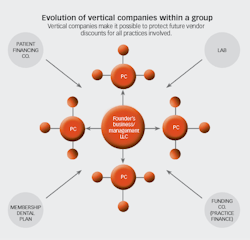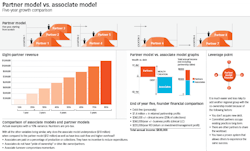Part THREE
Brady Frank, DDS
Editor’s note: This article is part three of a three-part series. Click here to read Part 1, and click here to read Part 2.
Editor's note ii: Watch the new DE's Recall Visit video with Dr. Brady Frank and Dr. Chris Salierno, as Dr. Frank elaborates further on the DDSO model. See if a DDSO is right for you and your practice by watching the video here.
DDSOs – (n.) A new breed of business models; dental support organizations (DSOs) that are majority-owned by dentists
Based on my experience of working with hundreds of retirement-age dentists, I have found that only about 6% are able to retire comfortably by the age of 59. However, given market conditions, it is no wonder that 94% of dentists are struggling, while only 6% are rising above. Multiple dental schools have opened, leading to increased competition. Insurance reimbursements have been reduced. Marketing budgets are higher. Overhead is higher, and DSO expansion has created a tougher market for private practices.
I was once so emotionally burdened by these conditions and their effects on my life, that I made the decision to intensely study the habits of the silent minority—the 6% of financially abundant dentists. I wanted to learn how they broke their chains and found financial and professional freedom, as well as getting back control of their time.
What I found amazed me. The 6% of dentists who defied the odds all used similar tactics, including protocols, systems, investments, tax-advantaged strategies, vertical companies, and dentist-owned transition strategies. They were a silent minority, but they had learned how to achieve success.
At first, I was highly skeptical about the methods and results of those top 6%. I thought that they were perhaps doing something unethical—or perhaps even illegal. How did they crack the code to double-digit growth year after year? They had solid new patient numbers, consistent addition of co-owners, value-added acquisitions, and vertical companies that helped scale their practices, drive down overhead, and increase profits. These practitioners were able to reinvest in income-producing assets that provided tax-advantaged income streams. They were able to practice dentistry as a choice—as opposed to a necessity—allowing them to be truly free.
In my research, I identified seven key streams of income that these doctors had built into their businesses. These streams of income can be thought of as “vertical companies” that are related, but separate, from the actual clinical practices (figure 1). In the following section, I will briefly explain four of the more successful and popular vertical company setups.
Popular and successful vertical companies
First, income-producing commercial real estate is a wonderful tax-advantaged, lifelong income stream. Using value-added approaches, properties can be purchased to accommodate additional locations and provide solid ROI for revenue originally generated at the practice level.
Second, building your own dental membership, savings, or discount plan within your practice can dovetail with your marketing strategy to provide strong return. Building your own plan allows you a passive stream of income. It is a wonderful lead-generation tool for new patients, and it facilitates strong patient retention numbers for current patients of record.
Figure 1: The evolution of vertical companies and multiple streams of income within the DDSO model requires a great deal of strategic planning as you transition to freedom.
Third, building your own private equity company is not as complicated as it sounds. I have used my own private equity to make investments in value-added or entrepreneurial satellite practices for years. This has generated both an interest-rate return and an equity return. Your private equity company will simply use your resources to “invest in yourself.” This is done by acquiring undervalued practice assets, increasing their values, and then harvesting equity returns (figure 2).
Figure 2: This graph demonstrates the various rates of return for different asset classes commonly utilized by dentists. The bottom line item represents the creation of your own private equity vertical company and investing in yourself in the dental niche.
Fourth, building your own dental lab through wholesale lab relationships is another great vertical to add value and quality to your practice.
There are different ways to set up these vertical companies, each with different advantages. There are also differences in practice models (figure 3). The details are found in my book and podcast series, Transition Time.
Figure 3: This is a simple comparison of a partner/co-ownership DDSO model versus an associate model under similar circumstances. Statistics are of actual client groups.
Getting started
If you find yourself short of your financial and retirement goals, please be aware that it is not your fault! Through the process of transitioning hundreds of dentists to financial freedom, I have found that the majority have simply been following the wrong blueprint. Don’t be hard on yourself if you are short of having $3 million in your retirement account and do not yet have several streams of passive income.
With new avenues and available training, it is not too late to take action. In my case, I analyzed the financial victories of the top 6% of practices and then applied them to my own “dentist-owned dental service organization,” or DDSO (see previous articles in this series for more discussion of this concept). I then created 45 universal “Transition Success Principles” that could guide dentists on their journeys to financial freedom. These principles can help dentists along their own unique paths (without going through as many costly mistakes as I have gone through!).
My life was vastly different prior to studying the 6% of dentists with financial abundance and total freedom. Before this time, in the early 2000s, I owned seven practices and employed 28 associates over a five-year period. Between associate turnover, administrative burdens, and clinical burdens, I had everything but freedom. After learning the lessons described here and forging a new path with top-6% mentors, everything changed.
I hope you have enjoyed this series and cheers to your future success!
Author’s note: Make 2018 your big year! Take the first step by reading my book or listening to my podcast, which are both entitled Transition Time. Let this be a shortcut to shave years off of your learning curve and provide actionable steps. The podcast allows the 14 modules of the book to come alive as dentists are interviewed about their transition to freedom.
Brady Frank, DDS, acquired Phasing Out Seminars in 2006. He has presented more than 36 seminars about transition strategies across the nation. Dr. Frank is also the founder of OsteoReady Implant Solutions. In 2016 Dr. Frank founded TransitionTime, which provides continuing education, consulting, and transition management coaching. Dr. Frank is the cofounder of multiple DDSOs in the United States. Email him at [email protected].










